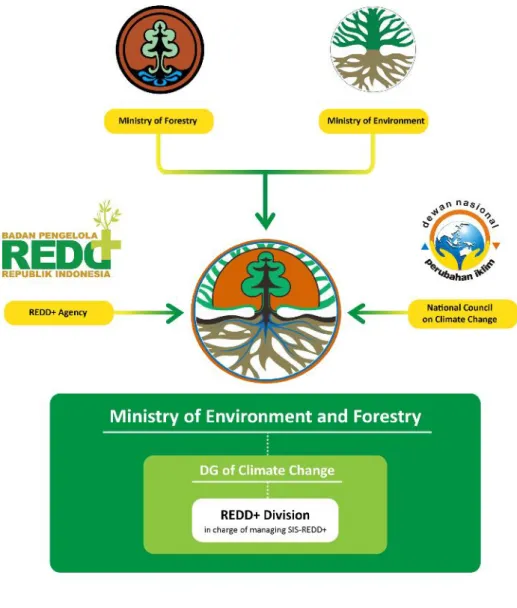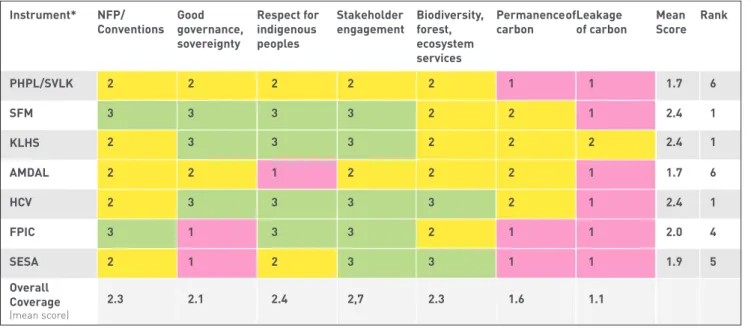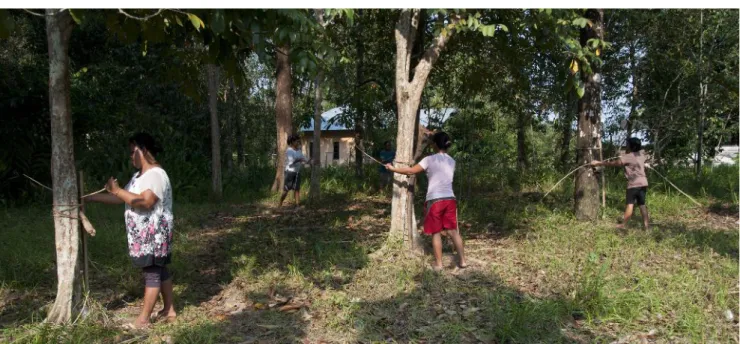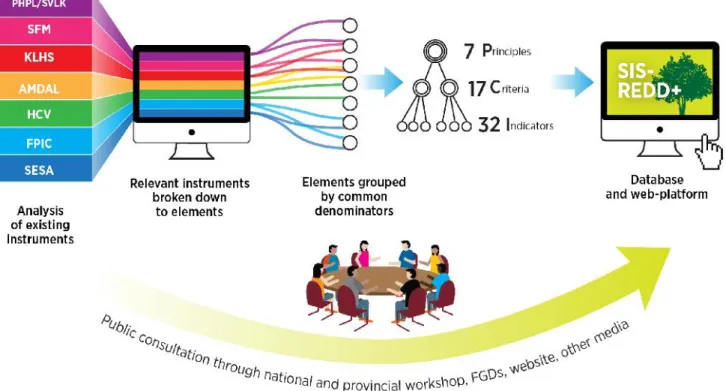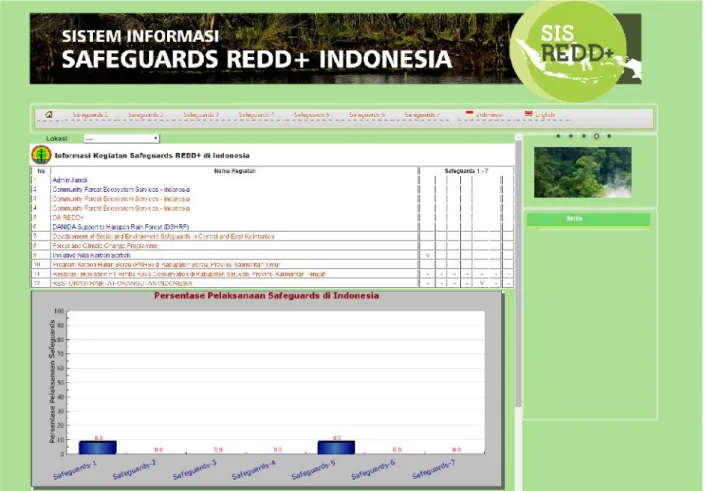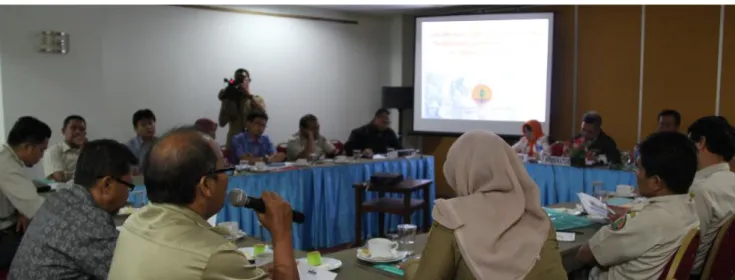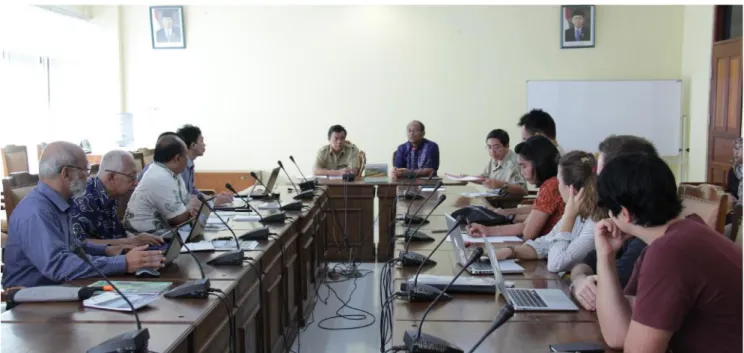Directorate General of Climate Change, Ministry of Environment and Forestry (2015): Conservation Information System for REDD+ in Indonesia: Moving towards an operational SIS-REDD+. Development of Principles, Criteria and Indicators (PCI) and Assessment Tools (APPS) Institutional structure for SIS-REDD+. SIS-REDD+ Sistem Penyedian Informasi Pelakasanan Safety Measures REDD+, or system for providing information on REDD+ safety implementation.
Within five years, SIS-REDD+, short for Information Assurance System on the Implementation of REDD+ Safeguard Measures, was created, pilots started and became operational. The development of SIS-REDD+ is well documented in various publications, presentations and internal reports issued between 2011 and 2015. This document concludes with a brief explanation about plans to further use and improve SIS-REDD+ in the future and a annex to complete the information provided regarding the development of this defense information system.
Safeguards and their role in REDD+ architecture
The term REDD, which stands for Reducing Emissions from Deforestation and Forest Degradation, was popularized at COP13 in Bali in 2007, where it was agreed that the development of the mechanism would be actively discussed in the Adhoc Working Group on Long-term Cooperation Actions (AWG) -LCA) at the UNFCCC. Indonesia, home to the third largest area of tropical rainforest in the world, has been one of the leading countries in the development and piloting of REDD+, whose results influence the dialogues and development of the mechanism globally. To design a system specifically to provide information on the implementation of safeguards in REDD+ activities as mandated in the UNFCCC resolution, then Ministry of Forestry/.
Collaboration with various stakeholders in the iterative process of SIS-REDD+ development has proven to be an effective and acceptable approach for the wider REDD+ stakeholder groups in Indonesia.
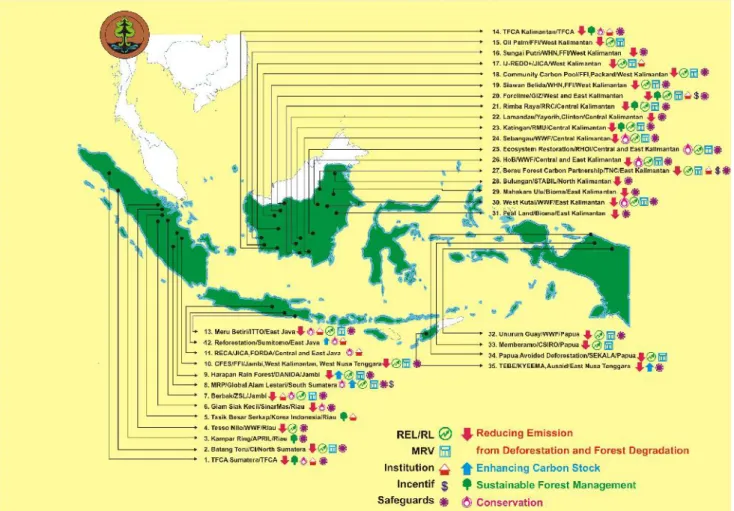
Developing System for Providing Information on REDD+
Safety measures are not new in forest management and forest products, both at local, national and international levels. Various policies, regulations and practices have been created to ensure that activities in forests and other landscapes have minimal negative impacts on local communities and the environment. The initiative was funded by the Ministry and the German government through the FORCLIME program of Deutsche Gesellschaft für Internationale Zusammenarbeit (GIZ).
Identify the most appropriate structure and mechanism for the REDD+ protection information system in Indonesia and design the institutional model for SIS-REDD+; and. It promotes transparency and participation and increases the trust of various stakeholders in the system, as well as a sense of ownership and acceptance. This approach also ensures that results fit within national and sub-national contexts and can be effectively implemented.
Safeguards Implementation (SIS-REDD+) in Indonesia
- Legal compliance and consistency with national forest programs
- Transparency and effectiveness of national forest governance
- Rights of indigenous and local communities (masyarakat adat dan lokal)
- Effectiveness of stakeholder participation
- Conservation of biodiversity, social and environmental services
- Reducing risk of reversals
- Reduction of emissions displacement
As a first step in the development of SIS-REDD+, the then Ministry of Forestry/Pustanling assessed and analyzed various existing mandatory and voluntary policies and regulations with the help of consultants and in consultation with stakeholders. Development of Principles, Criteria and Indicators (PCI) and Assessment Tools (APPS) The evaluation of existing mandatory and voluntary instruments in Indonesia marked the beginning of the efforts of the then Ministry of Forestry/Pustanling in collaboration with various stakeholders to develop appropriate principles, criteria, and indicators ( PCI)4 and the corresponding information system, structure and flow for SIS-REDD+. Over time, 7 principles, 17 criteria and 32 indicators were developed as the basis of the information provision system in SIS-REDD+.
During the reporting process, SIS-REDD+ requires REDD+ implementers to independently assess and report implementation of safeguards. It is provided together with the complete PCI under SIS-REDD+ in the Annex and can be downloaded from the SIS-REDD+ website (http://www.sisredd.menlhk.go.id). SIS-REDD+ aims to collect, process, analyze and present necessary information on how safeguards are managed and respected in REDD+ activities.
After the restructuring of the ministries and climate change efforts in Indonesia, the responsibility to further develop, implement and manage SIS-REDD+. In SIS-REDD+, the provision of information on the implementation of safeguards is designed to be delivered through the levels, from the project on the ground to the SIS management in the districts and beyond. When REDD+ is fully implemented, information will be passed from one level to the next as designed for SIS-REDD+.
As a systematic framework in the collection and presentation of information, SIS-REDD+ has the potential to assist other frameworks, such as FLEGT and the Forest Products Management Information System (FI-PUHH), in the collection of data and documents. The results of the SES will contribute to the implementation of SIS-REDD+, especially in providing support at the sub-national level and linkages to SIS-REDD+ at the national level.
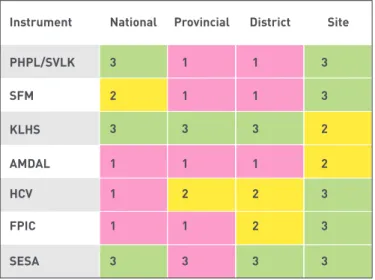
Other safeguards-related processes in Indonesia
In line with the preparation for REDD+ implementation and the development of REDD+ elements, a number of stakeholders have developed various REDD+ safeguard initiatives. The Principles, Criteria and Indicators of REDD+ Safeguards in Indonesia, or PRISAI, were developed by the REDD+ Task Force, whose work was transferred to the REDD+ Agency. PRISAI was originally created as a framework to filter, monitor and evaluate REDD+ activities at the project and jurisdiction level.
PRISAI was tested in several locations in the provinces of East Kalimantan, Central Kalimantan and Jambi. Standards or SES developed by the Climate, Community & Biodiversity Alliance (CCBA) and CARE International in collaboration with the REDD+ Working Group of East Kalimantan Province, Indonesia and Lembaga Ekolabel Indonesia (LEI) as the national certification agency, with funding from the Clinton Climate Initiative. The SES began to develop as a multi-stakeholder participatory initiative in 13 countries from May 2009.
Under SES, safeguards are based on key forest management issues facing the provincial government, and in Indonesia the framework has been adapted and tested for East Kalimantan and Central Kalimantan provinces. The Participatory Governance Assessment (PGA) is another multi-stakeholder safeguard initiative led by the UN-REDD program. The framework consists of 4 aspects/principles, 3 criteria/variables and 32 indicators and has been tested in 2012 and 2014 at national level and in different provinces and districts.
As such, the development of more than one framework assists government and REDD+ implementers in improving the performance of REDD+ safeguards, particularly at the sub-national and project level, where PRISAI, SES and PGA are intended to be used. These safeguard frameworks are currently being tested and improved for better coherence and linkage with SIS-REDD+ and to inform their implementation in SIS-REDD+ in the future.
Lessons learned from SIS-REDD+ development
As such, the development and trials of SIS-REDD+ at sub-national levels are crucial to ensure that the system can function effectively. Jambi and East Kalimantan provinces were chosen to be part of the trials because of the commitment of the local governments to REDD+ and the availability of a REDD+ Strategy and Action Plan (SRAP). According to the latest data from the Ministry of Environment and Forestry, there are at least eight active REDD+ demonstration activities in Jambi and East Kalimantan.
One of the tasks of the working group was to work with the East Kalimantan Development Agency (Bappeda) in the preparation of the REDD+ draft. As the institution that initiated the development of SIS-REDD+, Pustanling saw the potential and commitment of East Kalimantan to implement REDD+ safeguards at the sub-national level. Consultation events with key stakeholders in East Kalimantan were conducted in mid-2014 as the first step of the trial in the province.
Recent activities conducted in East Kalimantan included focus group discussions (FGDs) in 2014 and a gap analysis for the implementation of REDD+. 5 Latest available data before the province is divided into East Kalimantan and North Kalimantan provinces. From August to October 2015, a gap analysis for the implementation of REDD+ safeguards in East Kalimantan was carried out at the provincial level as well as in four districts.
Recommendations will suggest actions that the provincial and district governments in East Kalimantan should take to continue their implementation of REDD+ safeguards. Although it is yet to be a UPTD, the East Kalimantan government is committed to having a specific institutional framework.
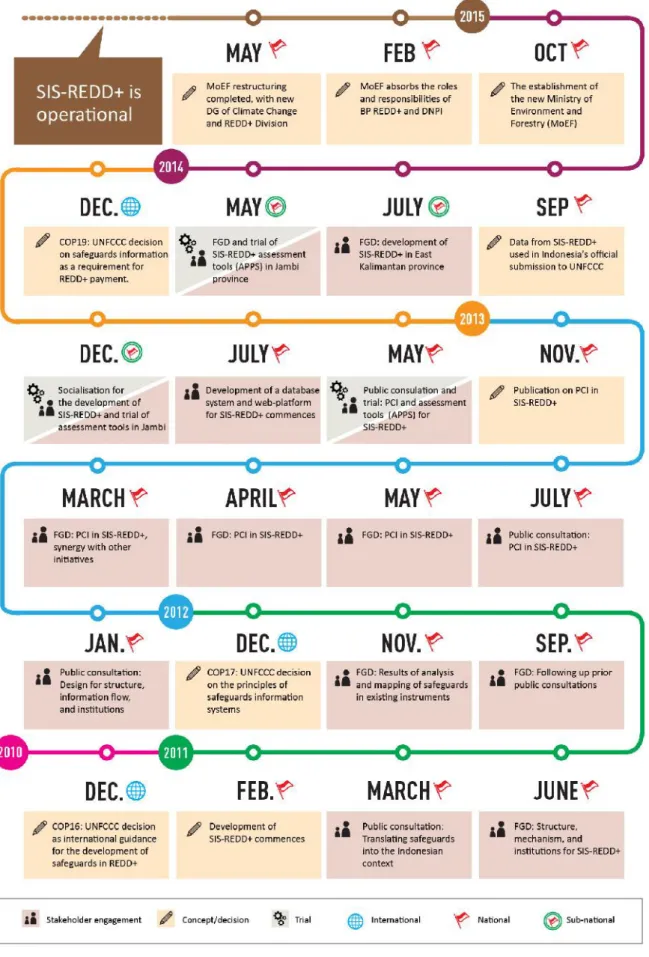
Way forward: further development and improvement
ANNEX
Annex: Principles, Criteria, and Indicators (PCI), and Assessment Tools (APPS) for System for Providing Information on REDD+ Safeguards
- Legal compliance and consistency with national forest programs
- Actions complement or are consistent with the objectives of national forest programmes and relevant to international conventions and agreements
- Transparency and effectiveness of national forest governance
- Transparent and effective national forest governance structures, taking into account national legislation and sovereignty
- Rights of indigenous and local communities (masyarakat adat dan lokal)
- Respect for the knowledge and rights of indigenous people and members of local communities, by taking into account relevant international obligations, national circumstances and laws, and noting that the United Nations General
- Conservation of biodiversity, social and environmental services
- Actions are consistent with the conservation of natural forests and biological diversity, ensuring that the actions referred to in paragraph 70 of the decision are not used for the conversion of natural forests, but are instead used to
- Actions to address the risks of reversals
- Actions to reduce displacement of emissions
REDD+ activities at all scales and contexts will contribute to transparent and effective forest management in accordance with national sovereignty. REDD+ activities will respect the rights of indigenous and local communities through actions appropriate to the scale and context of implementation. REDD+ activities will contribute to maintaining or improving the socio-economic well-being of indigenous and local communities by sharing the benefits fairly with them, including for future generations.
Availability of maps and/or any relevant documents of identified indigenous and local communities, including their rights in the field of REDD+ activities. REDD+ activities will recognize the value of traditional knowledge and offset the commercial use of such knowledge where appropriate. REDD+ activities will include effective strategies that preserve, conserve or restore biodiversity and ecosystem services for social and environmental benefits.
Evidence from remote sensing that REDD+ activities have avoided conversion of natural forests as defined in Indonesian government regulations. Reports on the results of remote sensing analyzes showing that REDD+ activities do not lead to conversion of natural/primary forests. REDD+ activities seek to reduce the risks of reversals through means appropriate to the scale and context, focusing on sub-national actions and policy initiatives at the national level.
Recognizing that monitoring and mitigating emissions drift are the responsibility of sub-national (FMUs, districts, provinces) and national governments, REDD+ activities will include mitigation strategies and support sub-national and national monitoring. Availability of assessment documentation and analysis on the types of emissions shifts likely to occur beyond REDD+ activities within national borders.
